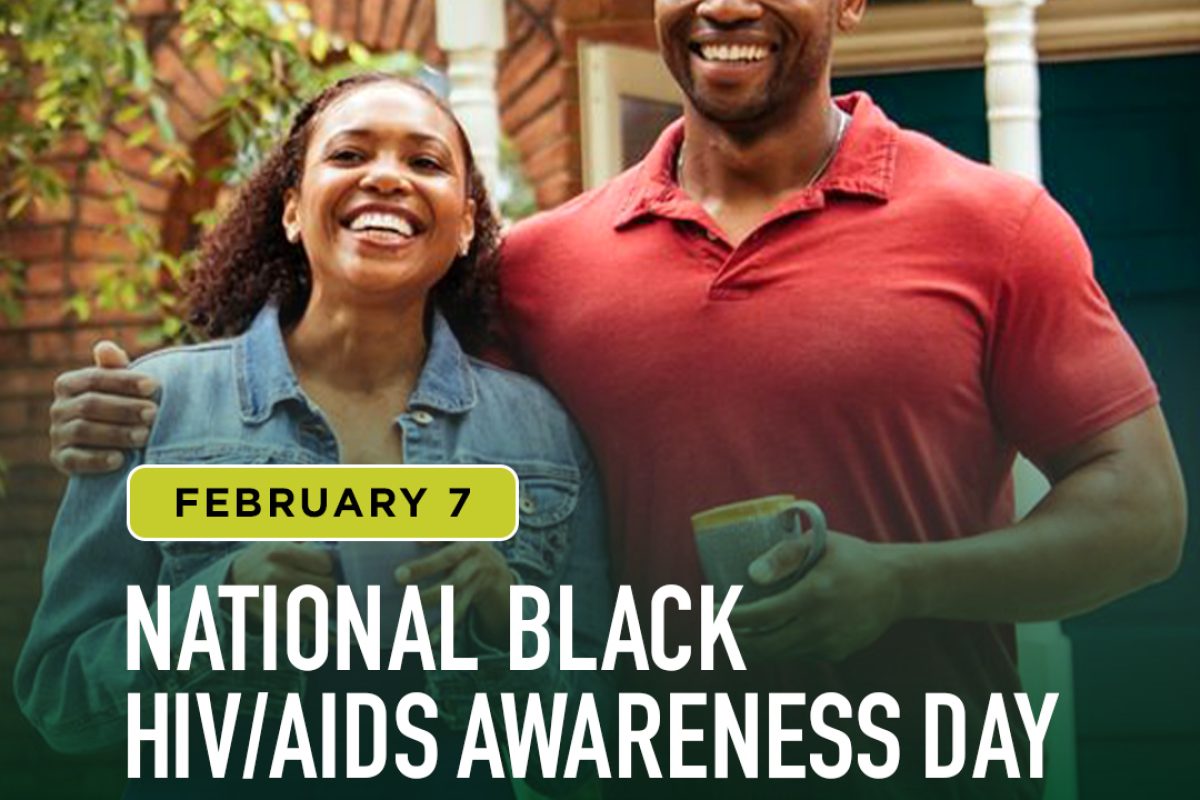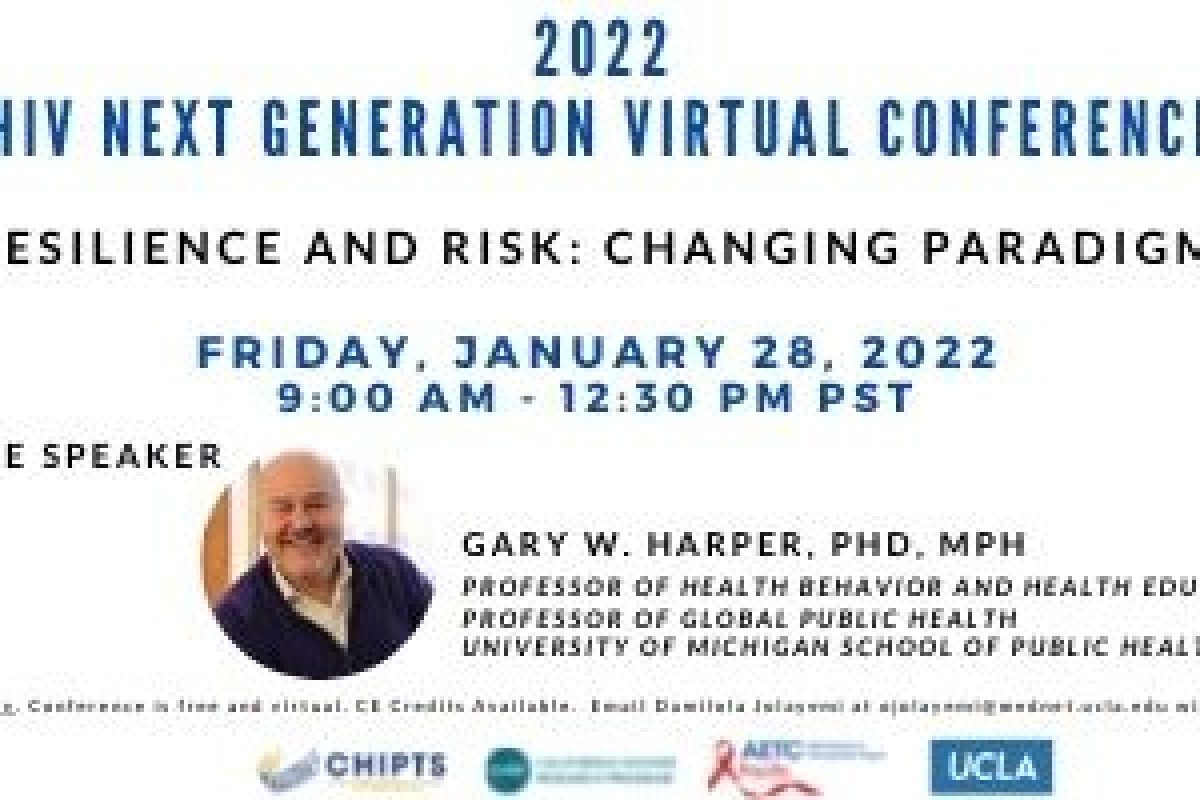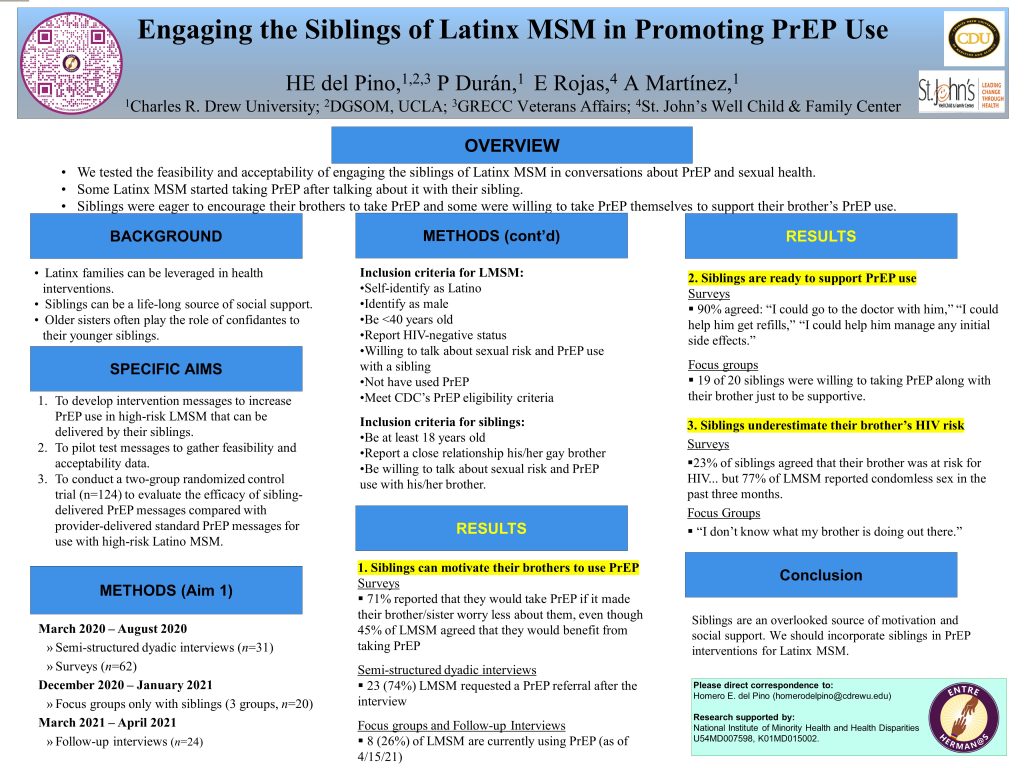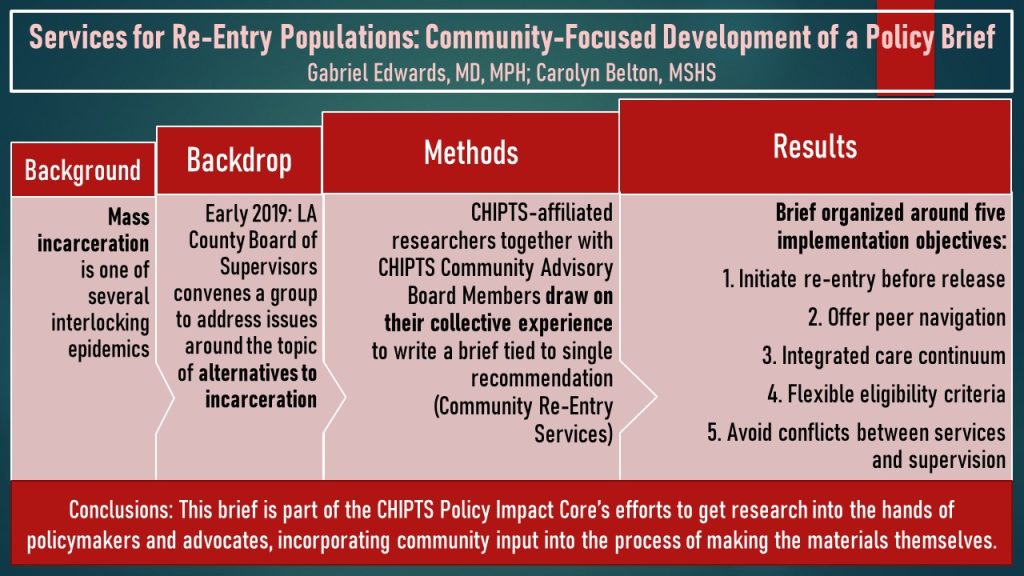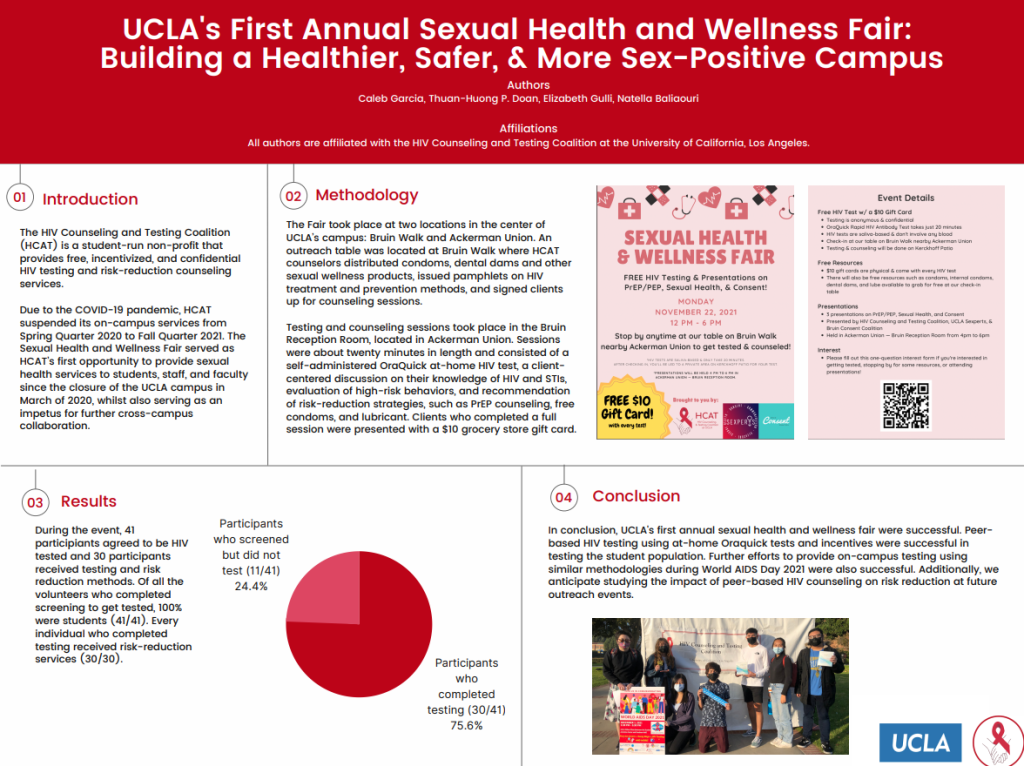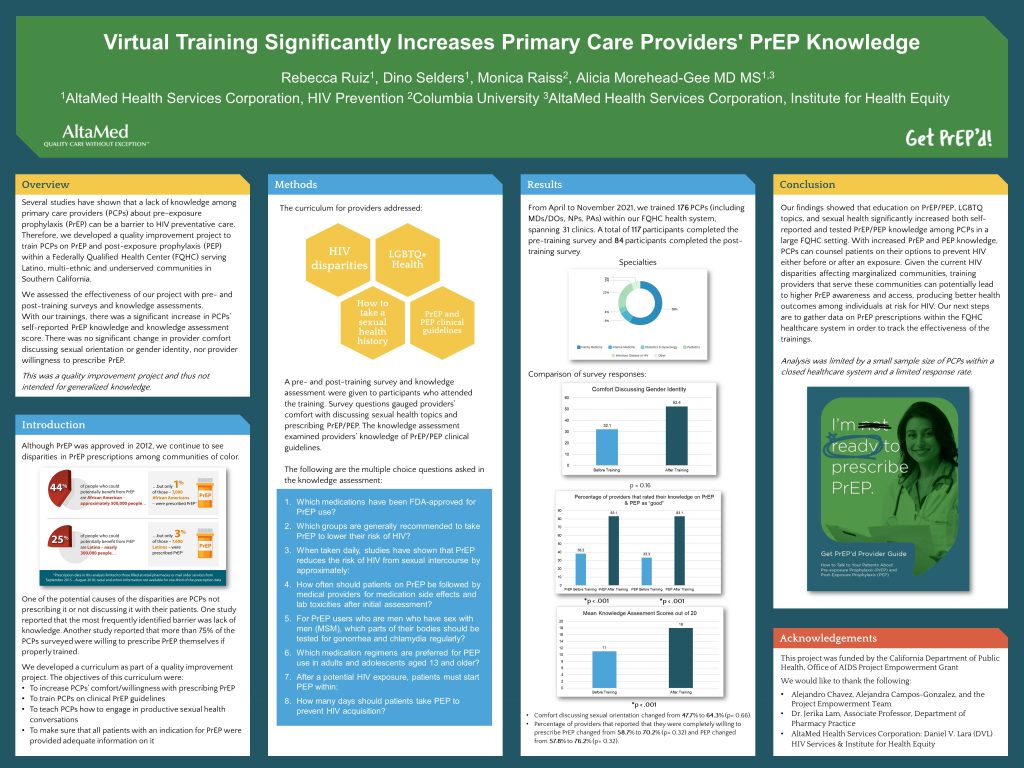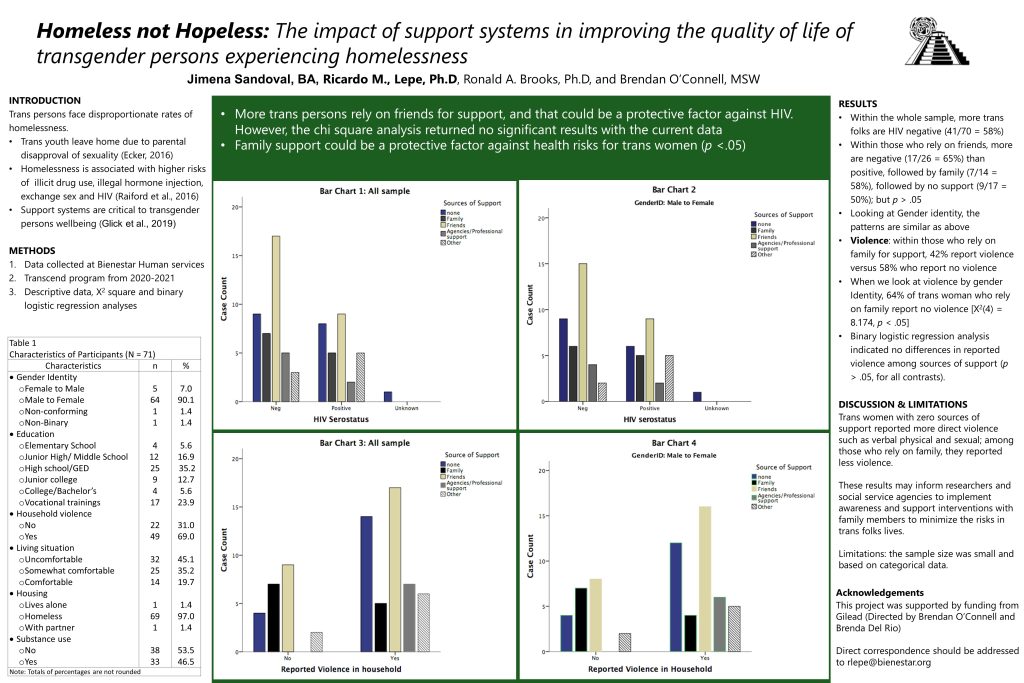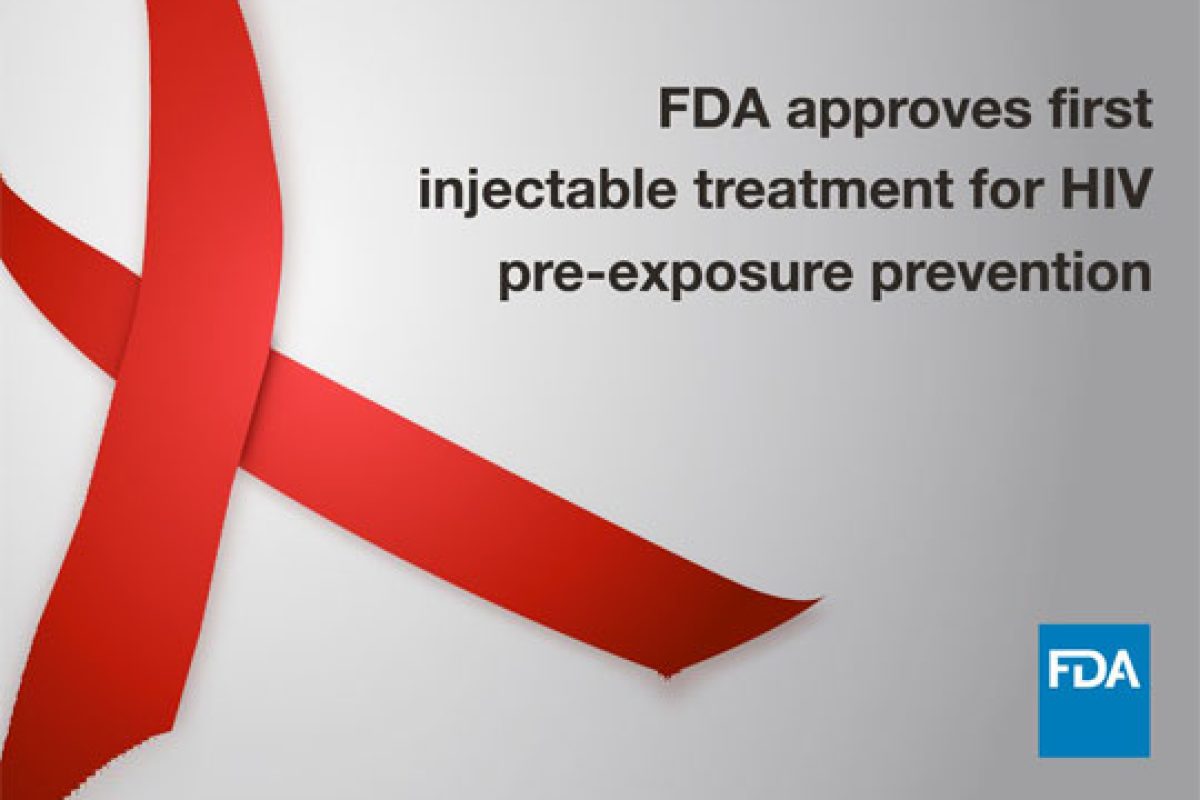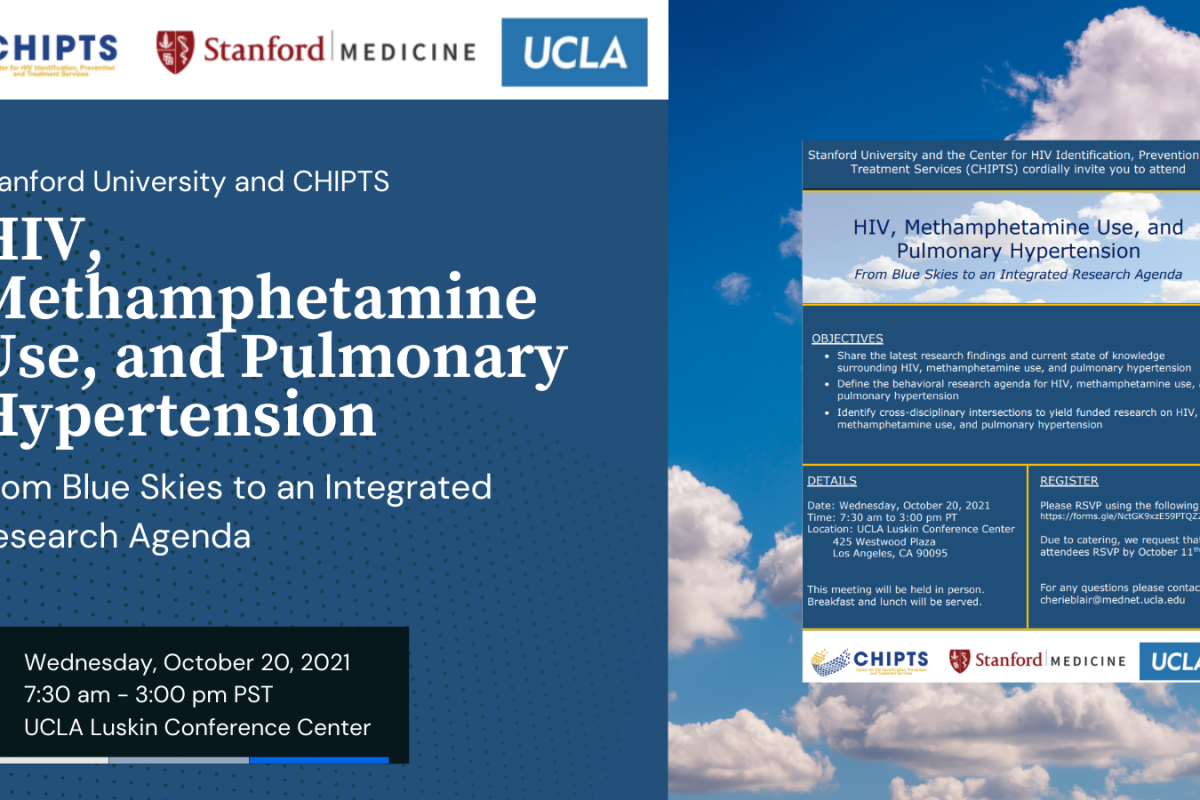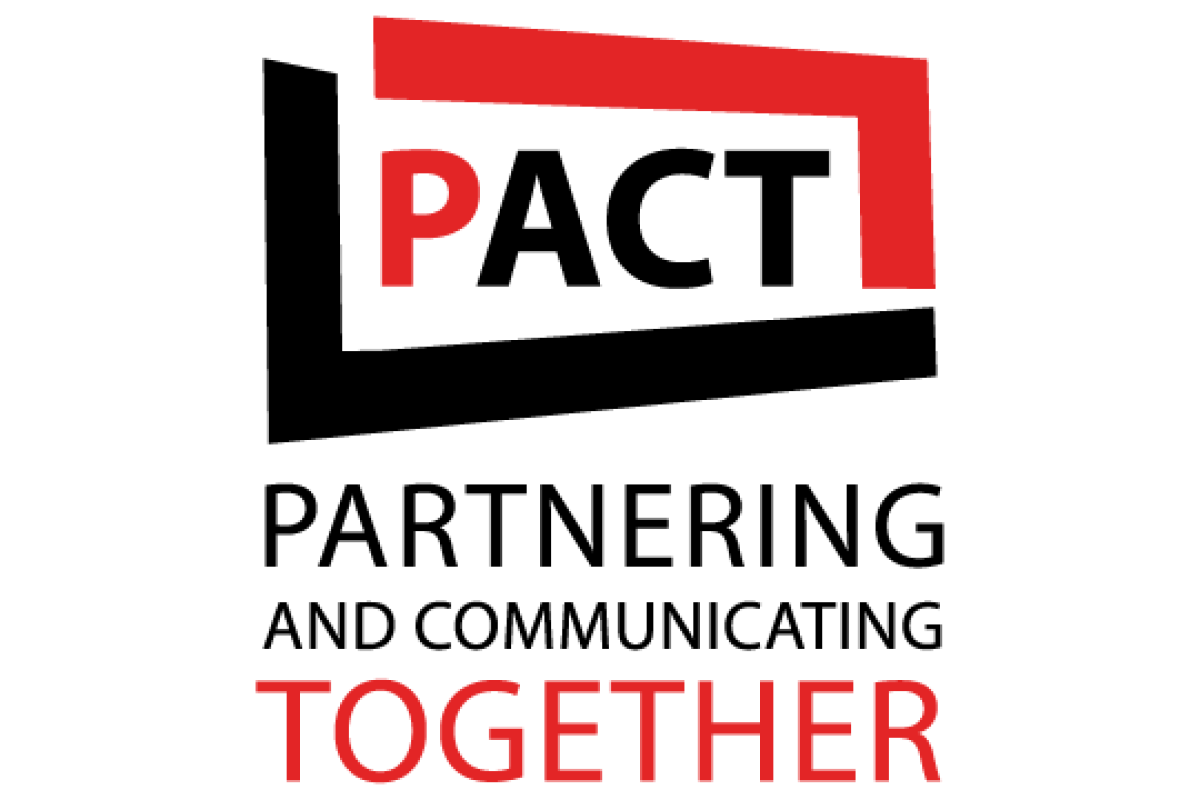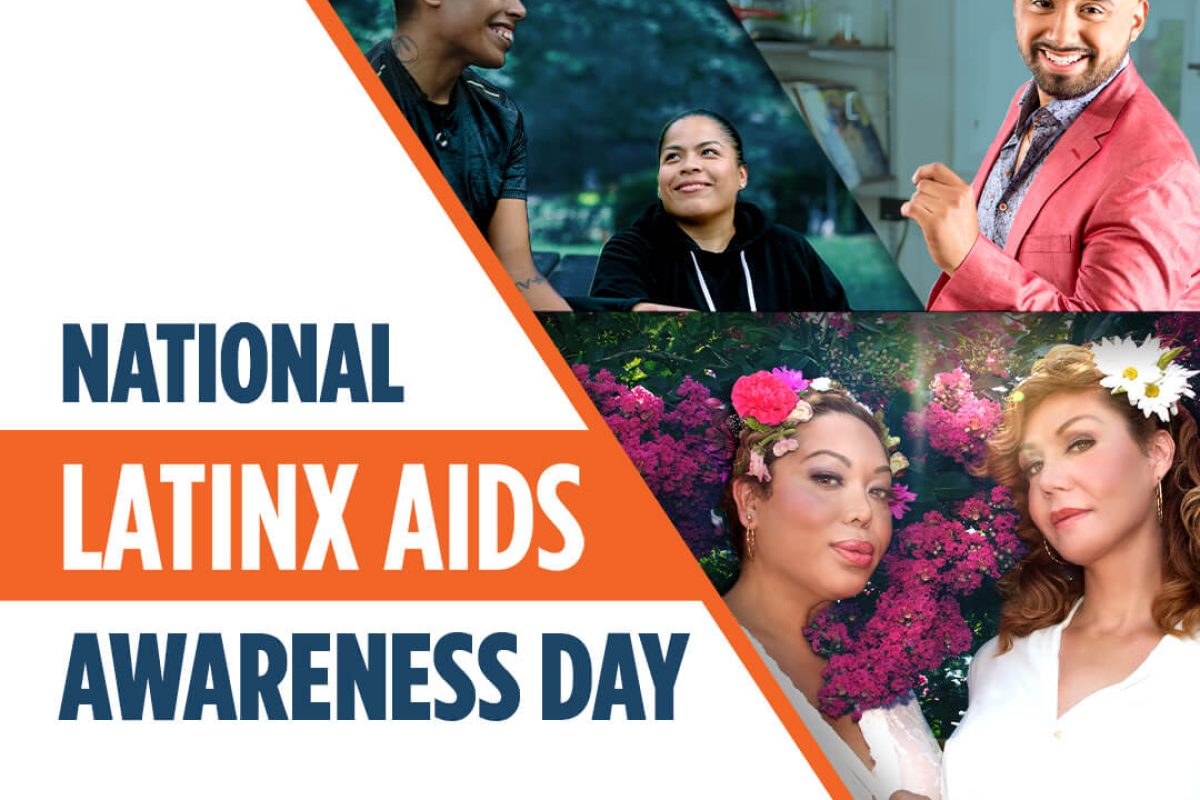The 2022 HIV Next Generation Conference hosted by CHIPTS welcomed 200 attendees for a day of presentations, discussions, learning and networking. The conference, facilitated by Dallas Swendeman, CHIPTS Development Core Co-Director, welcomed local attendees and participants from academic institutions, community-based organizations, health care institutions, and other organizations working to end the HIV epidemic. The day also provided a unique opportunity for cross-collaboration and mentorship.
The timely conference theme, “Resilience and Risk: Changing Paradigms,” was emphasized throughout the day’s program. Steve Shoptaw, CHIPTS Director, and Norweeta Milburn, CHIPTS Development Core Director, gave opening remarks to lay the groundwork for the conference. Gary W. Harper, Professor, Global Public Health, University of Michigan School of Public Health, offered an engaging and informative opening plenary.
The program proceeded with a set of two sessions featuring presentations and panel discussion that occurred concurrently. One session, moderated by Ron Brooks, CHIPTS Combination Prevention Core Scientist, centered on PrEP with Gay and Bisexual Men. Juan C. Jauregui discussed the results from a large global study administered through a gay geosocial networking app to assess sexual practices among gay and bisexual men who have sex with men during the ongoing COVID-19 pandemic. Martin Santillan Jr. highlighted the additional benefits PrEP provides to Latino gay and bisexual men beyond HIV prevention.
The other session, facilitated by Pamina Gorbach, CHIPTS Global HIV Director, centered on HIV and Substance Use. Cherie Blair presented on her project around HIV and methamphetamine. Amanda P. Miller described the prevalence of alcohol use and explored associations between alcohol use and HIV sexual risk among 1,200 pregnant women at risk for HIV infection attending an antenatal clinic in Gugulethu, Cape Town.
A second set of three concurrent sessions followed. This set included a session focused on PrEP with Women that was facilitated by Dvora Joseph Davey, CHIPTS Combination Prevention Core Scientist. Gloria Aidoo-Frimpong and David Adzrago discussed the preferences of Ghanaian immigrant women in the US towards different HIV pre-exposure prophylaxis (PrEP) delivery methods. Drew Mack’s presentation examined how Black women are disproportionately affected by HIV despite the advent of preventative methods like PrEP, and heightened accessibility to these medications through telemedicine. Co-presenters Dilara K. Üsküp and Omar Nieto shared their results from piloting an implementation strategy to raise awareness and uptake of PrEP among Latina cisgender women.
A concurrent session facilitated by David Goodman-Meza, CHIPTS Combination Prevention Core Scientist, focused on People Living with HIV. Karah Greene discussed the development of an online platform to promote social connectedness among older people living with HIV. Chenglin Hong highlighted the web-based mobile app intervention (LINX study) that aimed to address the social work and legal needs of Black sexual minority men living with HIV. Andrea. N. Polonijo provided an engaging presentation that examined sociodemographic differences in attitudes toward payment for research participation, perceptions of study risk based on payment amount, and preferred forms of payment.
The final session focused on Youth and HIV and was facilitated by Sabrina L. Smiley, CHIPTS Combination Prevention Core Scientist. Roxana Rezai provided an overview of important factors linked to alcohol misuse during COVID-19 stay-at-home orders in a sample of vulnerable youth at-risk for or living with HIV in Los Angeles, CA, and New Orleans, LA. Joshua A. Rusow presented on HIV-risk sexual activities among sexual minority adolescents in the United States. Co-presenters Erik Storholm and Wilson Vincent examined the impact of socioeconomic distress, intimate partner violence, depressive symptoms, HIV-related social support, resilience, and healthcare empowerment on HIV care continuum engagement.
Over the course of the virtual conference, poster presenters shared their innovative research with attendees during interactive breakout poster sessions. See posters: https://chipts.ucla.edu/news/2022-chipts-hiv-next-generation-conference-resources/
Scholarship awards in honor of William Cunningham, a beloved CHIPTS Core Scientist who embodied the tenets of mentorship and supported the work of new and emerging investigators to address HIV needs and disparities, particularly in under-served communities, and Mark Etzel, a treasured CHIPTS administrator whose work centered around addressing policy and supporting grassroots community engagement to improve health outcomes in communities impacted by HIV, were awarded to Anne E. Fehrenbacher, Cheldy Martinez, and Juan Solis, respectively.
Finally, CHIPTS Co-Director Raphael J. Landovitz gave the closing remarks, reminding attendees of the conference’s purpose and highlighting the need for more interventions to address HIV prevention and treatment needs and gaps during this period of the pandemic and beyond.
See below for oral presentation PDFs and available recorded presentations.
Welcome and Opening Remarks
Recording: https://www.youtube.com/watch?v=DJENQJSn54g
Norweeta Milburn, PhD, Director, CHIPTS Development Core
Steve Shoptaw, PhD, Director, CHIPTS Administrative Core
Conference Facilitator and Announcements:
Dallas Swendeman, PHD, Co-Director, CHIPTS Development Core
Opening Plenary
Recording: https://www.youtube.com/watch?v=sseFDnlZ1oo
Gary W. Harper, PhD, MPH, Professor, Health Behavior and Health Education, University of Michigan School of Public Health.
Presentation Title: Promoting resistance and resilience for holistic health: The power of LGBTQIA+ youth
Presentation Summary: N/A
Panel 1: PrEP with Gay and Bisexual Men
Recording: https://www.youtube.com/watch?v=sJicMGWEKRw
Panel Presentations:
1. Correlates of sexual contact, COVID testing and comfort attending sexual venues during the COVID-19 pandemic in a global sample of gay, bi-sexual, and other men who have sex with men
- Juan C. Jauregui, MSW, MPH, Doctoral Student
Slides: Download here
Summary: The presentation describes how gay social and sexual venues are important targets for HIV prevention engagement and how GBMSM continued to remain connected through gay geosocial networking apps throughout the pandemic. The presentation examines the impact of COVID-19 on GBMSM’s social and sexual venue attendance.
2. Using PrEP is being part of a larger movement: Additional individual and community level benefits of PrEP use among Latino gay and bi-sexual men
Slides: Download here
Summary: The presentation examines the additional benefits of using PrEP specifically among Latino GBM PrEP users. Semi-structured interviews were conducted with participants to identify feelings and emotions experienced, plus any additional benefits gained from using PrEP.
Panel 2: HIV and Substance Use
Recording: https://www.youtube.com/watch?v=FwlrEGI83wU
Panel Presentations:
Panel discussant: Pamina M. Gorbach, MHS, DRPH Global HIV Director, CHIPTS Co-Director, UCLA Center for AIDS Research Program on Biobehavioral Epidemiology and Substance Use.
1. Sexual risk among pregnant women at risk of HIV infection in Cape Town, South Africa: What does alcohol have to do with it?
- Amanda P. Miller, PhD, MSc
Slides: Download here
Summary: The presentation focused on alcohol use and HIV describing the interrelated public health issues associated with adverse health outcomes for the mother and fetus. The presentation examined associations between reported alcohol use and HIV risk behaviors among pregnant women in Cape Town, SA
Panel 3: PrEP with Women
Recording: https://www.youtube.com/watch?v=ntneb3UUrJs\
Panel Presentations:
1. Examining interest in HIV pre-exposure prophylaxis delivery modalities among Ghanaian immigrant women in the US
- Gloria Aidoo-Frimpong, MA, MPH, PhD Candidate and David Adzrago, PhD(C), MSW, MPhil, PhD Candidate
Slides: Download here
Summary: The presentation objective was to examine factors associated with willingness to use PrEP delivery methods (i.e., daily oral pill, injectable, microbicide gel, vaginal ring, subdermal implant, vaginal film) among Ghanaians – a subgroup of African immigrants.
2. I want to see what that’s about: Black women’s insights on accessing PrEP via a telehealth app
- Drew Mack, BSc, Medical Student
Slides: Download here
Summary: The presentation discussed the use of qualitative interviews to explore Black women’s’ perception of using telehealth through an app and using telehealth to access Pre-Exposure Prophylaxis.
3. Piloting teleprep information sessions: An implementation strategy to increase PrEP awareness and optimize PrEP uptake among Latina Cisgenders women
- Dilara K. Üsküp, PhD, PhD and Omar Nieto, BS
Slides: Download here
Summary: The presentation discusses a pilot that aims to use an implementation strategy to increase PrEP awareness and optimize PrEP uptake among Latina cisgender women (LCW) through use of PlushCare. PlushCare is a stand-alone telemedicine “app” that exclusively provides virtual/remote delivery of clinical services, including PrEP.
Panel 4: People Living with HIV
Recording: https://www.youtube.com/watch?v=c_4z-wt1J8g
Panel Presentations:
1. Developing an online platform to improve social connections for older adults aging with HIV: Lessons learned from multi-site discussion groups
Slides: Download here
Summary: The presentation discusses the lessons learned regarding the technological barriers encountered during the facilitation of focus groups with older people living with HIV.
2. HIV stigma is associated with patient-reported outcomes and quality of life among Black sexual minority men living with HIV
- Chenglin Hong, MSW, MPH, PhD Candidate
Slides: Download here
Summary: The presentation examines the effect of HIV stigma, which might be pronounced among Black sexual minority men living with HIV due to the Intersectionality and multiple minority stressors. Findings underscore the critical associations between HIV stigma and patient-reported mental health outcomes and quality of life.
3. How does payment shape research participation decisions? Results from a national survey of people living with HIV
- Andrea. N. Polonijo, PhD, MPH
Slides: N/A
Summary: Summary: Payment for participation in HIV research is a common practice, yet little is known about how payment affects individuals’ research participation decisions. Using data from a U.S. national survey of people living with HIV (N=292), we examined sociodemographic differences in (a) attitudes toward payment for research participation, (b) perceptions of study risk based on payment amount, and (c) preferred forms of payment. We find payment may influence prospective HIV research participants’ risk–benefit calculus and participation, and that a onesize-fits-all approach to payment could differentially influence participation among distinct
Panel 5: Youth and HIV
Recording: https://www.youtube.com/watch?v=NOJdR_ioWIA
Panel Discussant: Sabrina L. Smiley, PhD, MPH
Panel Presentations:
1. Alcohol misuse during the COVID-19 stay at home orders among youth at risk or living with HIV: A study in Los Angeles and New Orleans
- Roxana Rezai, MPH, Doctoral Student
Slides: Download here
Summary: The presentation discusses marginalized subgroups such as sexual and gender minorities, youth living with HIV, and youth experiencing housing insecurity are particularly susceptible to alcohol use and misuse. The study mentioned examines important factors linked to alcohol misuse during COVID-19 stay-at-home orders in a sample of marginalized youth and young adults at-risk or living with HIV in Los Angeles, CA and New Orleans, LA.
2. Violence experiences are associated with HIV transmission risk over one year among a prospective sample of sexual minority adolescents in the United States
- Joshua A. Rusow, PhD, MSW
Slides: Download here
Summary: The presentation examines mental health symptomology, minority stress experiences, and interpersonal violence as a potential contributing factor to HIV transmission risk behaviors over one year among sexual minority adolescence.
3. Impact of resilience, social support, and healthcare empowerment on HIV care engagement and viral suppression among young Black sexual minority men with HIV in the US
- Erik Storholm, PhD and Wilson Vincent, PHD
Slides: Download here
Summary: The presentation examined the associations of multiple latent predictor variables known to be related to HIV outcomes such as socioeconomic distress, intimate partner violence, depression, resilience, and HIV related social support with HIV care engagement among. The presentation discusses test whether healthcare empowerment mediates the impact of these latent predictor variables have HIV care engagement.

